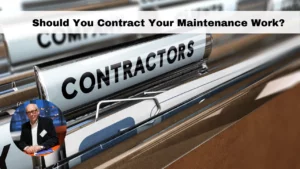In the May column, I discussed results that a mill had experienced in the ten years following implementation of initiatives with a primary focus on cutting costs as quickly and extensively as possible. In summary, it proved to be a financial disaster.
In this article, I will discuss what happened in another pulp mill during a similar time period.
PRIMARY FOCUS: RELIABILITY IMPROVEMENTS
This mill decided to focus primarily on reliability improvements instead of cost reduction alone. This program included the following activities:
- Development of a clearly spoken and well-established partnership between operations, engineering, and maintenance.
- Replacement of a reactive maintenance policy with one that is planned and scheduled. Formerly, less than 10% of all maintenance work was planned and scheduled; ten years later, more than 85% of all work was executed after being planned and scheduled.
- Implementation of a strong vibration analysis program; prior to the project, the average vibration level was 0.23 in./sec, but today, it has been decreased to 0.11 in./sec.
- Professional training of lubricators; this training resulted in better filtration, including water removal, better seals, oil testing, and use of fewer types of lubricants. Cost for lubrication was reduced by 60%.
Dynamic balancing of all rotating equipment above 1,000 rpm before being put into service; - Improvement of many equipment bases by installation of Jack-bolts to facilitate better alignment precision;
- Marking and rotating of electric motors and rolls in store at an interval of twice per month;
- Implementation of alignment training, standards, and execution;
- Analysis and improvement of stores inventory and services; by maintaining a service level of more than 96% to maintenance, stores value was reduced by more than 30%.
- Adherence to preventive maintenance schedules increased more than 90%.
RELIABILITY BRINGS RESULTS
During the first three years of the reliability improvement program, maintenance costs increased a total of 8% (2.5% to 3.0% per year). During the same period, reliability – and, consequently, production throughput – increased steadily from 83% to 90%.
After the initial three years, the reliability continued to increase to 92%, resulting in a reduction of maintenance costs by 40% (Figure 1). Figure 2 shows the financial impacts of the reliability improvement program.
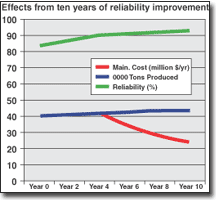
FIGURE 1. During the first three years, maintenance costs increased 8% and then began to fall, ending with a final reduction of 40%.Reliability and production throughput increased steadily to a total of over 92% (time and quality performance).
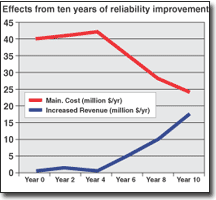
FIGURE 2. Short-term increase in maintenance costs of about $3.3 million resulted in savings of $17 million annually. Value of increased and sold production represented $18 million annually ($ values are per year).
MAKING TOUGH CHOICES
When the cost saving initiative started, pulp prices were low and profitability was low, from a short-term perspective, compared with other mills in the corporation.
The fast-pace cost reduction actions included the following:
- Operations took over maintenance and only did maintenance work that was judged necessary.
- Planning of work was not done.
- Scheduling ceased to exist.
- The Preventive Maintenance program was handed over to the operators, without training them in what to do or how to inspect. The Preventive Maintenance inspectors were laid off.
- Shutdown crews were merged with another mill that was a one-hour drive from the mill.
- Painting programs were abandoned.
- Training of craftspeople stopped, etc.
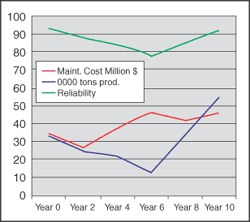
Figure 1. The first two years maintenance costs dropped, then started to increase. Reliability and quality production throughput also went down and continued to do so for the six years before reinstatement of basic maintenance processes.
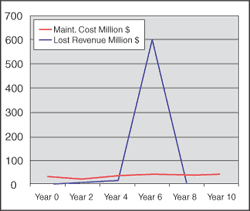
Figure 2. Same data as in chart one but in financial terms ($ values are per year). Short- term maintenance savings during two years caused disastrous results after only three years.
NO LONG-TERM ADVANTAGE.
In the first years after the cost saving initiative began, maintenance costs dropped from $35 million/year to $27 million/year, and results were hailed as good. However, reliability soon started to decline.
When the initiative started, reliability was 93%, but bottomed out at 78% six years later, at a time when pulp prices had doubled.
The drop of 15% in reliability, and even more in quality production output, corresponded to a loss of more than 300,000 tons during some very good years when product could have been sold at top prices.
Financial losses, due to low reliability resulting from the cuts in maintenance spending, were conservatively estimated to have exceeded $1.2 billion during a three-year period.
TIME TO TURN AROUND
After realizing the catastrophic consequences of its cost saving initiative, the mill focused on bringing its maintenance up to world-class status.
Results have been very encouraging, and today the mill is a top performer, with reliability now approaching 94%. Maintenance costs have gone up, but so has quality production throughput. Manufacturing costs per ton are also lower.
The actions taken to bring maintenance to world-class status included:
- Reinstating Preventive Maintenance inspectors and revising the Preventive Maintenance program;
- Bringing maintenance back as a central mill function;
- Developing a partnership between maintenance and operations;
- Focusing on planning and scheduling;
- Developing employee capabilities toward joint performance goals;
- Investing capital in new equipment and restoring worn out equipment
During the 16th annual Pulp & Paper Reliability and Maintenance Conference in Atlanta, held jointly with Paper Summit this past March, a similar experience was presented as a case study.
For copies of this presentation, please contact me at:[email protected]



